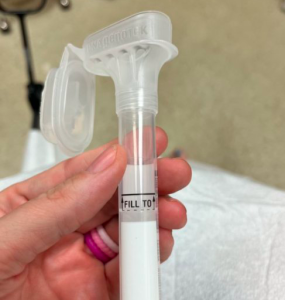 If you’ve read my previous blogs, you’ve probably noticed I have several on the topic of breast cancer. Four years ago, I wrote a blog about BRCA genetic testing. At that time, I wasn’t ready to have it done.
If you’ve read my previous blogs, you’ve probably noticed I have several on the topic of breast cancer. Four years ago, I wrote a blog about BRCA genetic testing. At that time, I wasn’t ready to have it done.
I’ve actually been putting it off for quite a while. November 26th will mark 10 years since I lost my sister to breast cancer. For the past several years my OBGYN has been trying to get me to do this testing. Until recently, I’ve declined. This was never because it was invasive or anything. All I had to do was spit a few times in a tube.

For some reason, this year was different. Maybe it’s because I’m approaching the age at which my sister was diagnosed. Maybe I am finally at peace with whatever the outcome may be. Whatever my reasoning, at my yearly appointment in September, I decided to just go ahead and do it.
So, what actually is BRCA (breast cancer) genetic testing?
It’s a test that’s done to determine if you have changes (mutations) in your DNA that increase your risk of breast cancer. Mutations in either breast cancer gene — BRCA1 or BRCA2 — significantly increase the risk of breast cancer.
The BRCA gene test is offered to those who are likely to have an inherited mutation. This is based on personal or family history of breast or ovarian cancer. So, if you have a family history of either of those, I highly recommend talking to your doctor about the testing.
My results took a lot longer to get back than I expected. So there were several weeks of worry and anxiety while I waited to find out. The initial email came 26 days later but got lost somewhere in email cyberspace, so the follow-up email from my doctor’s office wound up coming almost six weeks later!
The results showed that I was negative for the BRCA gene.
Negative results mean that there is no increased risk of BRCA-related cancers, while positive test results means that a mutation has been identified and that the person is at high risk of BRCA-related cancers.
That was great news for me, because had it been positive, it would’ve meant having a preventative double mastectomy and total hysterectomy. I can’t even imagine what those surgeries and their recoveries would be like.
The follow up said that while my test results for the gene were negative, my increased lifetime risk to develop breast cancer is at 30%. That may not sound terrible, but when you think about one in three people that it seems pretty daunting.
The week after I got my results, I had a phone call with my OBGYN to discuss the next steps.
Since I do have an increased risk, she advised me to get established with a breast health clinic. She recommended I get a breast MRI six months after my yearly mammogram, so that way I’ll be checked twice a year instead of once.

She also told me that the breast health clinic is up-to-date on all the latest things. They’re aware of newly-discovered genes and the most recent research since that’s their primary focus. It is up to me whether I want to do this, but obviously having one more scan each year is totally worth it to stay on top of my health.
You may remember hearing about actress Angelina Jolie’s having this test and the follow up surgeries. Her mother died of breast cancer, and her test showed that she carried the BRCA1 gene mutation with an 87% chance of developing breast cancer and a 50% chance of developing ovarian cancer. She chose to have a preventative bilateral mastectomy and reconstruction back in 2013. According to the Beth Israel Deaconess Health Center, genetic testing has become even more sophisticated since then. Also, mutations on genes other than BRCA1 and BRCA2 have since been identified as possibly increasing one’s risk of breast cancer.











